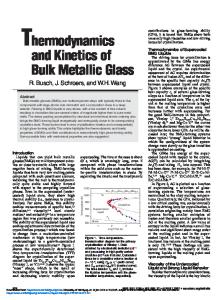Metastability and thermophysical properties of metallic bulk glass forming alloys
- PDF / 289,148 Bytes
- 7 Pages / 612 x 792 pts (letter) Page_size
- 34 Downloads / 361 Views
I.
INTRODUCTION
The phenomenon of undercooling a liquid below its melting point into the metastable regime presents a unique opportunity to produce a ‘‘frozen liquid’’ or commonly called glass when crystallization can be suppressed. In order to predict the transformation products when a system is driven away from full thermodynamic equilibrium into the undercooled liquid state, knowledge of the thermodynamic properties becomes essential. Due to the general experimental limitations in undercooling metals and alloys over sufficiently long periods of time, the knowledge of the thermodynamics of undercooled liquids has been limited so far to very few elements and alloys.[1,2] In this regard, the current generation of zirconium-based ‘‘bulk metallic glasses’’ opens new perspectives due to the relatively easy accessibility to the metastable glass state and the exceptionally high stability against crystallization in the undercooled liquid.[3,4] These alloys present the unique opportunity to produce bulk metallic glasses (i.e., volumes greater than typically 1 cm3) within the temperature and time constraints of industrial processing. Their exceptionally deep eutectic phase equilibria are thought to facilitate glass formation by the favorable convergence of physical properties such as (1) increased solid vs liquid specific heat difference resulting in a decrease of the driving force for crystallization, (2) an increased interfacial tension, (3) increased viscosity, (4) high reduced glass transition temperature Tgo/Tm, where Tgo is the ideal glass transition R.K. WUNDERLICH, Staff Scientist, is with the Materials Science and Engineering Department, Technical University Berlin, D-10623 Berlin, Germany. H.J. FECHT, Head of Institute, is with the Materials Science Department, University of Ulm, D-89081 Ulm, Germany. This article is based on a presentation made in the ‘‘Structure and Properties of Bulk Amorphous Alloys’’ Symposium as part of the 1997 Annual Meeting of TMS at Orlando, Florida, February 10-11, 1997, under the auspices of the TMS-EMPMD/SMD Alloy Phases and MDMD Solidification Committees, the ASM-MSD Thermodynamics and Phase Equilibria, and Atomic Transport Committees, and sponsorship by the Lawrence Livermore National Laboratory and the Los Alamos National Laboratory. METALLURGICAL AND MATERIALS TRANSACTIONS A
temperature and Tm is the eutectic temperature, and (5) good solubility of oxygen. One of the most stable metallic glasses has been found by Peker and Johnson in Zr-Ti-Ni-Cu-Be alloys at cooling rates of less than 10 K/s.[3] By measuring the thermodynamic properties of this alloy and comparing the results with that of other metals in the highly undercooled liquid state, some of the underlying principles governing the glass forming ability become evident. As an alternative, the disordered glassy state can be reached by solid-state amorphization, for example, by mechanical alloying.[5] With the glassy state representing a local minimum in the Gibbs free energy, i.e., true metastability, it is interesting to
Data Loading...











